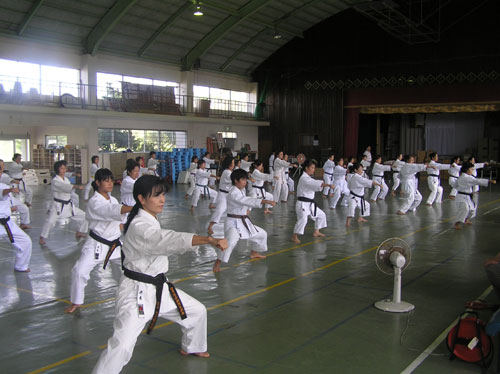
Senior Japanese ladies training class
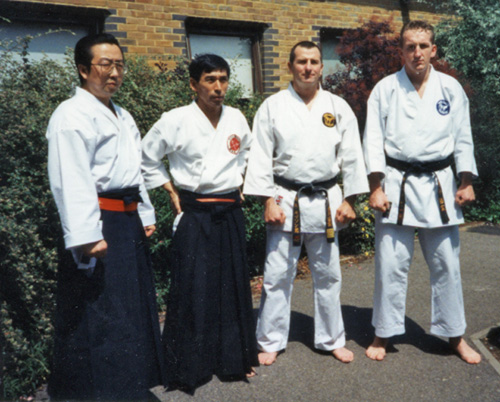
With high ranking Grandmaster Kisho Inoue, of the Okinawan
and Japanese Ryukyu Kobujutsu association and one of his Shihans
traditional Honbu Dojo
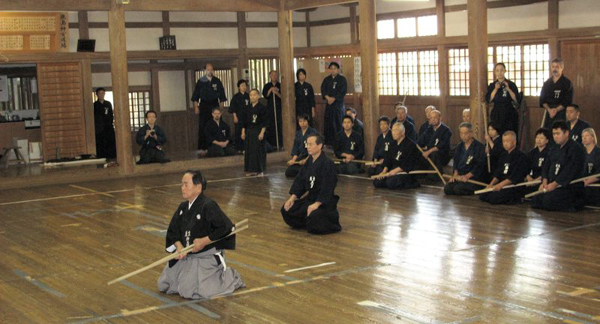
Kobudo class in progress
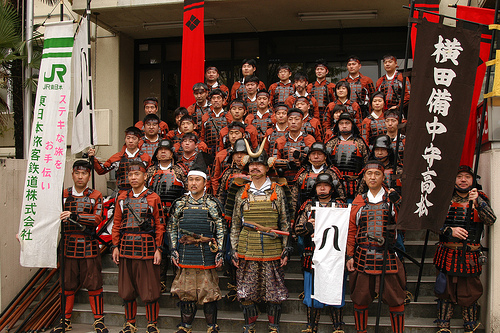
Karate in the early days
It was no fancy pants stuff, karate then, compared with some of today's standards was more physically and mentally demanding and lot more aggressive. You have to understand, at that time, karate was just beginning in this country. It had just come over from Japan or Okinawa where the philosophy was not winning trophies, keeping fit, or for having a nice little hobby after work. Karate was taught back then as a kill or be killed fighting art and clearly something that should not be confused with some of the watered down soft styles that are being taught in many so called clubs today.
This type of training and philosophy gave me a strong mental and physical attitude and built a good foundation towards real fighting situations.
Once in a while we were served up to visiting Japanese teachers
Our Japanese teachers were all very tough and very determined men, although a few, (just a few) could be at times helpful and polite in their teaching manner. Others however, thought the war was still on and we were their prisoners.
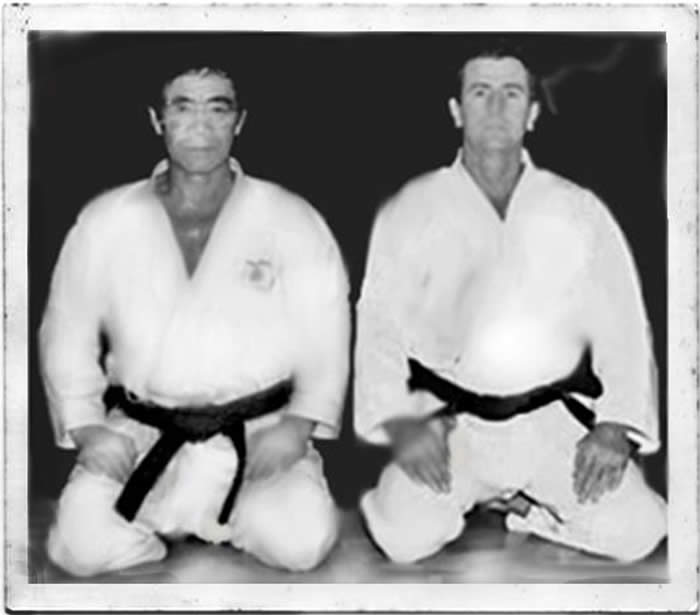
With the great Shotokan Grand Master, Kancho Hirokazu Kanazawa 10th Dan
One of Japans most famous and talented instructors
Kancho Hirokazu Kanazawa is one of the few remaining karateka privileged to have studied under supreme Okinawan karate master Gichen Funakoshi who is credited as the modern day father of karate bringing karate over to mainland Japan from Okinawa in 1922.
Master Kanazawa, is one of the world’s most renowned and respected traditional karate masters alive today. He won the notorious ‘All Japan karate Championship’ Kumite championship in 1957 and in 1958 won the Kata and Kumite Titles. On one occasion winning the finals whilst nursing a broken wrist from an earlier event.
Although trained in Judo in his early years, Kanazawa took up karate whilst at University under the late headmaster of the shotokan style Matsatoshi Nakayama (10th Dan). Breaking away from the JKA (Japan Karate Association) in 1973, Kanazawa set up SKIF (Shotokan Karate-do International Federation). SKIF is now the world’s largest Shotokan association, having over 2 ½ million members in over 100 countries.
Hanshi has had the privileged and honour to have trained under this great karate man. |
Weekend courses outside in mid winter
Our Japanese masters would take us training to the windswept Scottish mountains. Sometimes in the middle of winter forced into the freezing sea or lochs to do sparring, kicking, punching and kata techniques. Thinking back, we must all of been completely bloody mad.
Training in these days was a non stop regime of 2 or 3 hours of grueling basic repetitious techniques. Everyone was very competitive with each other. Being roughly grabbed, pushed, punched, kicked, slapped or hit with a wooden staff by our instructors along the way was normal practice.
A typical warm up
1,000 kicks over a chair, or to each other, 1,000 punches in a low horse stance, bunny hops around the dojo (banned today), star jumps to the last man standing which usually lasted over half an hour where the instructor would only stop when the last man gave up. This usually ending up with us having very sore, blistered or bleeding feet.
Throughout these long years I have certainly trained in many an odd place, such as; working men's clubs, dingy shop basements, church halls as well as training outside in all weathers. Some of the indoor premises were old establishments that had stone floors or unpolished floor boards that were so rough that your feet would often feel like they were on sand paper and being ripped to shreds. Over the years of pounding the floor with bare feet your soles became very hard, also losing some of the feeling where you could stand on a tack without noticing or feeling it.
Sparring in these days was a very aggressive affair
Sparring at times seemed nothing more than all out war. No protective equipment was available in these days and heavy physical contact was the norm.
It was plain fear and survival of the fittest, take no prisoners was the motto. Anything went, head butts, knees, even bitting, grabbing the hair, throat or groin was deemed acceptable, although some students did get carried away with this. You could grab your opponents legs if they tried a kick you and throw them hard to the ground, followed by punching them semi hard to the body or skin contact to the face (that's a laugh). Also dropping down with your knee on you opponent was a good way to wind them and then jump on them to wrestle them into a strangle hold submission. You were expected to do some moves lightly but usually we all got very excited and carried away most of the time.
As you can imagine, there were lots of injuries, bruising, strains, broken fingers, ribs, toes, black eyes, loose teeth or a broken blooded nose. Sometimes a fracture of the arm, leg, fingers and toes it all happened now and again. However the truth is, it just all seemed to us back then part of training and was the only attitude you seemed to have towards others. This to me is understandable especially growing up in such a place at that specific time and really something you just accepted without question or thought. No one really cared anyway, myself, instructors or students.
Sparring was usually done one to one, although you could find yourself fighting 2,3, 4 or more opponents.
We had special names for these fighting sessions; the "Pub Fight", "Street Fight" "The all in fight" "Smash & Grab" or "Grab & Smash" where everyone in the dojo attacked anyone near them, just like a big battle. That was fun!! The fights were actually a big free for all and would only finish to the last man standing, the winner (who was let off doing the hundred press-ups or the hundred bunny hops). Saturday and Sunday were special sparring sessions being 3 to 4 hours long where we all usually ended up totally soaked in sweat, battered, bruised or hurt, but usually in most cases very sore and bloody.
You never forget these times, anyway the pain and aches from past injuries which are still with me, ingrained into my memory today won’t allow me to forget.
I have often wondered how on earth I ever managed to survive these crazy mad times.
Health & Safety, Child protection, Risk Assessment, CRB, Insurance " where there's blame there's a claim. What's that, never heard of it back then!!
Come to think of it, I would be worth an absolute fortune now if the compensation culture was around then, although all the people I have damaged would be very well off to.
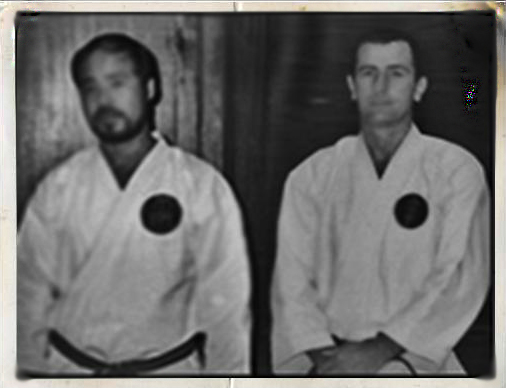
The late Soke Shigeru Kimura 10th Dan Shukokai Karate 1941 - 1995
Seen here in Glasgow, Scotland.
Soke Shigeru Kumura was a legend of Shukokai Karate.
He took up Kendo and Judo before moving on to Karate aged 16yrs
He won the Japan karate championship title and won it again a year later.
He believed that karate should be realistic. His fast and powerful methods of training were obvious to his students and opponents. He died aged 54 and is sadly missed by all traditional martial art students who trained under him and those who knew of him..
When I first came down to London from Scotland, I trained for a while at master Tatsuo Suzuki's dojo.
When I moved later to Brighton I trained at sensei Joe Robinson's dojo. I also did some boxing at Brighton Boys Club along with my karate training. The coach at that time as I remember and told was a former British champion, later he sent for my professional licence and I remember he said that I can earn £60 a fight being a professional boxer. However, doing 7 days a week hard training started to take it out of my body physically, especially as I was also working at a very physical job and therefore decided I should concentrate soley on my karate. Along with my karate I also did judo under sensei Robinson and gained my brown belt. However, I wanted to open my own karate club, although teaching a lot of karate students was a brand new experiance for me. My thirst for training was far stronger than having a club, so I often went back and fourth when I could manage, back to London to continue with my training at Master Suzuki's dojo.
Later I was privaliged to be invited by master Tatsuo Suzuki to take part in a demonstration, to be held at the Brighton Boys Club. This demonstration was for sensei Fuji, one of sensei Suzuki's instructors who wanted to open a karate school at the Boys Club. Along with myself, there was the British Competition Wado Champion and some of the Worlds top Japanese Wado Ryu karate masters, one being of course sensei Fuji himself.
As I remember, although I may have forgoten some others, they were: sensei Meiji Suzuki, sensei Maeda, sensei Shiamitsu, sensei Sakagami and Commenting was Tom Hibbit MBE, who was at the time the UK Wado Ryu secretary under Master Suzuki. Later he become the head of the AMA, one of the largest karate sanction associations in the UK.
After doing a demonstration of karate fighting techniques and sparring with the Wado champion, sensei Kuniaki Sakagami then asked me to spar with him, with sensei Meiji Sukuki as referee.
During the fight, things got a little heated and I made heavy contact, spliting open sensei Sakagami's lip.
I could see in his face he was not to happy with that and got really angry. Especially when the other Japanese masters started laughing. Even though I stopped and bowed, he fiercley attacked me, ending up with me being trapped up-against the spectators who were sitting all around the hall. He aimed a powerful front kick at my gedan level (below waist), not nice thing to do. Anyway luckily, I managed to stop it from making contact with a strong downward sweeping block (gedan barrai). However, the kick was so strong it lifted me right of the ground. Afterwards, while in the changing room I noticed my arm was fast swelling up like a balloon and was starting to give me a lot of intense pain. However, I thought nothing of it at the time, it's something you get used to and expect in those days when sparring in karate. It wasen't until later, I thought, may as-well pop along to hospital, well just in case. Glad I did, it ended up my arm was badly broken.
Anyway, the following week I was at sensei Fuji's very first class along with my arm in plaster.
Note: Master Fuji would always bring another Japanese instructor along with him to every class and on that very first one, yes, it was only, sensei Sakagami.
During the lesson I noticed he was hobbling a little bit. However, I dare not ask why, as that would be very disrespectful of me to do so, although I was told later by a student that it was because of my sweeping block. Well that pleased me and eased all the hassle you get with having a broken arm.
Unfortunatly, the class only lasted months due to lack of students.
I remember one thing about sensei Fujii, he was a very snappy dresser and for me a great karate man, especially being the all Japan open style champion. I also remember, he had a fantastic powerful sokuto fumikomi (side kick).
Lastly, I just like to say, if not for my gedan barrai block, my chances of producing any children would probely be zero. Good old gedan barrai!!
|